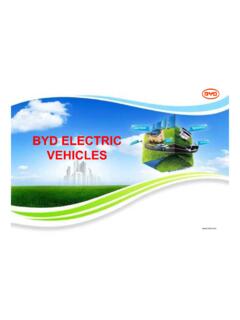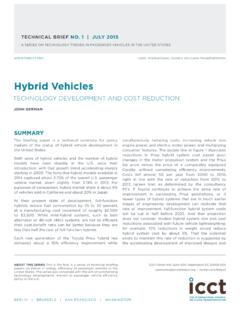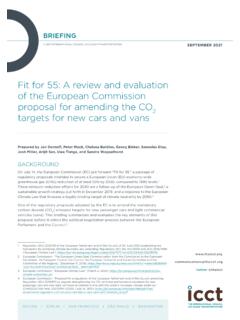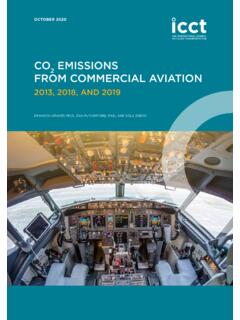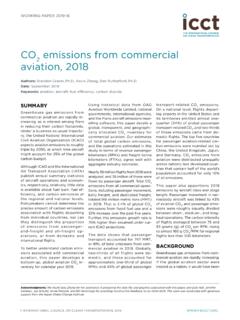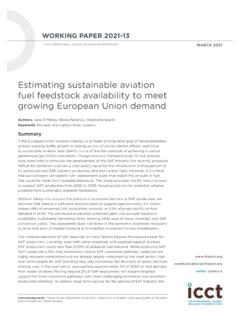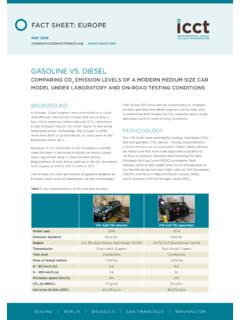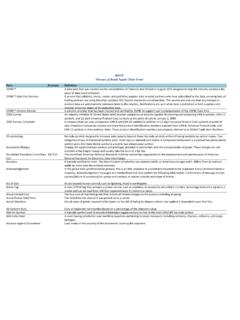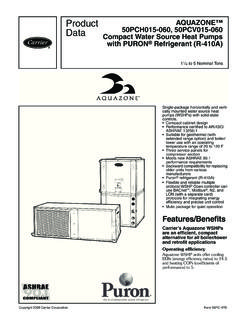Transcription of On-Board Diagnostics (OBD) Program Overview
1 1 On-Board Diagnostics (OBD) Program Overview California Air Resources Board Allen Lyons April 2015 Mexico City 2 Presentation Outline oOBD History and Background oOBD Requirements oOBD Certification oOBD Enforcement oOBD and Smog Check Certification Enforcement Regulations 3 OBD II Regulation - History Adopted by Air Resources Board in 1989 oImplementation began in 1994 oFull Implementation achieved in 1996 oOver 150 million OBD II-equipped vehicles operating in the United States today Vehicle Applications (< 14,000 pounds) oPassenger cars oLight-duty trucks oMedium-duty vehicles and engines OBD requirements adopted for heavy-duty vehicles in 2005 (HD OBD, > 14,000 pounds) oFull implementation in 2013 4 Keeping In-use Cars and Trucks Clean Low emission vehicles depend on numerous and complex emission controls to clean up a dirty combustion process oEmission solutions are increasingly complex Malfunctions can increase emissions to many times the certification standards oDeterioration oImproper maintenance oManufacturing defects oTampering 5 On-Board Computer Modern vehicles use On-Board computers oControl fuel metering (fuel injection) oActuate EGR and purge valves, etc.
2 ORegulate anti-lock braking oControl transmission OBD II is an extension of the computer 6 What is On-Board Diagnostics ? A system in the engine s On-Board computer that monitors the performance of almost every emission-related components for malfunctions Uses information from sensors to judge performance of emission controls oSensors do not directly measure emissions Mostly software that runs Diagnostics in the background 7 Malfunction Indicator Light (MIL) A warning light will appear on the vehicle's instrument panel to alert the driver if a malfunction is detected 8 OBD Monitoring Scope Monitoring Categories Catalyst Efficiency Misfire Detection Evaporative System Secondary Air Fuel System Exhaust Gas Sensors Exhaust Gas Recirc. Crankcase Ventilation Engine Cooling System Cold Start Strategies Variable Valve Timing Direct Ozone Reduction Air Metering System Transmission controls Forced air systems Hybrid System Engine speed/angle Virtually every source of excessive vehicle emissions is monitored 9 Standardized Information When a malfunction is detected, information about the malfunctioning component is stored Technicians can download the information with a scan tool to help fix vehicle Information also used by Smog Check inspectors Information is communicated in a standardized format so one tool works with all vehicles (SAE and ISO standards) 10 Why Is OBD Needed?
3 Maintain Emission Control Systems In-Use oDeterioration with age oOldest 20% of vehicles cause 60% of pollution Help Technicians Properly Diagnose and Repair Complex Problems 11 Other Benefits of OBD Encourages design of durable and robust emission control systems Helps keep emissions low by identifying emission controls in need of repair Provides for effective/inexpensive emission inspections Works for life of the vehicle 12 Durable Components Cause of MIL Subject to Emissions Warranty o3 Year / 50,000 miles (EGR, O2, etc.) o7 Year / 70,000 miles (catalyst, computer) o15 Year / 150,000 miles for PZEV Durability Less Expensive than Replacement 13 Consumer Cost Benefits Early Detection of Malfunctions oPrevent secondary malfunctions ( , detect misfire before catalyst damaged) oMarginal components replaced during warranty Eliminates Unnecessary Repairs oFault codes and other scan tool data give information about area of malfunction or the specific component oContrast: tailpipe test simply identifies high emissions, but not fault information, repairs are often trial and error 14 Aspects of an Effective OBD Program Certification Enforcement Regulations OEM submits application Staff review of application Certification Enforcement/ remedial action, in-use issues Clarification of requirements (reg.)
4 Updates/guidance documents) 15 Amendments The regulation has often been amended to improve effectiveness and to accommodate new vehicle technologies Adopted 1989 Amended in 1991, 1994, 1996, 2002, 2006, 2015 Other minor amendments through other rulemakings Rulemakings Available on the ARB OBD website: 16 OBD Requirement Concepts Emission threshold monitoring oMalfunction Indicator Light on when emissions increase X% oUsually based on x standards o8-20 per vehicle Non- emission threshold monitoring oComprehensive components oFunctional, rational, electrical o75-200 Diagnostics per vehicle standardization Requirements oInformation OBD system required to store OBD testing and validation oPre- and post-production; by vehicle manufacturer 17 Basic OBD Diagnostic Procedure System waits for right monitoring conditions Observes Signals Entering the Computer oDirectly from the component/system, or oRelated to performance of component/system Verifies Peformance /Functionality / Rationality oMalfunction criteria Notifies Driver of Fault oMIL illumination oUnique fault code storage oFreeze frame information 18 Example of how OBD works: Catalyst Monitoring Oxygen sensor data used to evaluate catalyst conversion performance Manufacturer correlates tailpipe emissions with catalyst system performance based on oxygen sensor data.
5 OBD system is calibrated to turn on MIL and store fault information for the catalyst when performance drops to the point where emissions exceed malfunction threshold ( X HC or NOx standard) 19 RICH LEAN RICH Monitoring Method: Oxygen sensors before and after the catalyst(s) Oxygen storage used to infer HC conversion efficiency LEAN Catalyst Monitoring Technology 20 20 (e)(1) 21 Catalyst Monitor Emissions Correlation (e)(1) 22 Certification Vehicle manufacturer required to submit certification application for review and approval. Application includes: oDetailed specifications for all monitors in format prescribed in regulation oDemonstration emission test data oAny other information/diagrams/data used to support OBD system ARB Mail-Out #06-23 23 Certification Require detailed disclosure of strategies at the time of certification Careful review of trained engineers to understand and look for loopholes/shortcomings oOBD certification engineers need to understand OBD system nearly as well as the manufacturer engineers oNeeded for effective certification and enforcement Ability to still get certified and sell with shortcomings but require correction for future model years oDeficiencies are important part of successful Program Reasonable amount of data included to support compliance of system ( , demonstration data) 24 Summary Table (sample portion)
6 Component/ Fault Monitor Strategy Malfunction Threshold Secondary Enable Time MIL System Code Description Criteria Value Parameters Conditions Required illum. (example) Catalyst P0420 oxygen storage rear oxygen sensor > .75 engine speed 1000<rpm<4000 20 seconds two trips period vs. front oxygen engine load >20% once per trip sensor period ECT >70C MAP > 25 kPa fuel system status closed loop disable conditions: MIL not illuminated for DTCs: P0139 P0105 P0133 EGR System P0401 difference in MAP delta MAP < 10 kPa vehicle speed > 35 mph 3 seconds two trips readings ECT > 70C fuel system status fuel-cut battery voltage > volts disable conditions: MIL not illuminated for DTCs: P0105 Manifold Absolute Pressure (MAP) Sensor: MAP High P0108 Out of Range High MAP Voltage > V (110 kPa) Engine Speed > 300 rpm Continuous one trip MAP Low P0107 Out of Range Low MAP Voltage < V (15 kPa) Engine Speed > 300 rpm Continuous one trip MAP Rationality P0106 Comparison of High Rationality two trips modeled MAP to MAP Voltage: < ( 65 kPa) Engine Speed 1000 to 5000 2 seconds actual MAP signal Vehicle Speed > 10 mph calculated load > 50% Monitor runs whenever enable Low Rationality > ( 25 kPa) Engine Speed > 1500 conditions are MAP Voltage: Vehicle Speed > 10 mph met Fuel System Status Fuel Cut 25 In -Use Compliance Key to ensuring as-built cars actually match design/certification.
7 Does OBD system work as described by manufacturer? If not, find out why. Combination of manufacturer self-testing and agency testing Divided into distinct regions to focus on areas where problems have previously been found 26 Compliance Testing: Manufacturer Self-Testing Demonstration Testing oShows that malfunctions are detected before emissions exceed thresholds ( , X emission standards) Communication standardization via J1699 oMakes sure that production vehicles properly handle/communicate required information through datalink Diagnostic function oManufacturers have to implant faults and verify detection on production vehicles IUMPR - In-use Monitor Performance ratios oTracks how frequently monitors really run on the road. Data reported to ARB for review. 27 Compliance Testing Agency Enforcement Testing Confirmatory testing of demonstration vehicles oARB duplicates testing to verify that malfunctions are detected before emissions exceed threshold levels ( , x standards) Actual in-use vehicle testing by engineers with implanted faults, dyno and on-road driving, data logging.
8 ODo the monitors run when they are supposed to? oDo they detect malfunctions that are implanted? oIs the right data stored when a malfunction is detected? And so on. 28 Enforcement: Remedial Action Criteria to determine appropriate remedial action in enforcement regulations Remedial action varies from nothing up to recall and fines oField fix software oService bulletin oNotification to OBD clearinghouse: Mandatory recall if a major monitor is non-functional, or if defect prevents I/M testing 29 Background: OBD II and I/M OBD II designed from the beginning as an I/M Tool oComprehensive monitoring requirements oFault thresholds based on emission standards Readiness Indicators 30 OBD Based I/M Procedure the MIL work? (Key on engine off) the vehicle ready for an inspection? No recent code clearing the MIL commanded off? If YES to all 3: PASS If NO, remedy as necessary: Fix MIL lamp or wiring Conduct more in-use driving and return for re-inspection Fix detected fault and return for re-inspection 31 Benefits over Tailpipe I/M More comprehensive fault detection oAll emission-related components individually monitored oCold start problems detected oEvaporative emission problems detected oBroad in-use testing conditions oOBD failure rates ASM failure rates Convenience oFaster (less than 5 minutes) oNo surprises (MIL off = pass, unless recently serviced) oLess expensive 32 Pre-Inspection Benefits Most detected faults are addressed before Inspection Failure rates / Benefits much higher than Smog Check database would indicate Data indicates that benefits may be 3 times as high as indicated by Smog Check failure rate.
9 33 Time/Cost Savings OBD II Inspections can be completed in a matter of few minutes Cost savings could be $15 to $35 per test Continued tailpipe testing along with OBD inspections not cost effective: o$300K to $900K per ton HC+NOx Calendar Year Cost Savings Range ($/year) 2015 $107M - $305M 2020 $139M - $356M 34 Fraud Detection VIN Vehicle specific Should not change Readiness Profile A given make/model/year should have a specific readiness profile Possible to change (running change), but usually rare ECU Address A given make/model/year should have specific value that won t change A given vehicle should have specific values. Most should not change from one inspection to the next 35 More Fingerprinting Data Cal ID / CVN Combinations are make/model/year specific. May change (field fixes), but still make/model/year specific Communication Protocol Shouldn t change Mostly useful for older vehicles (all newer vehicles use same protocol) Supported Parameter IDs (PID Count) Calculated value based on the types of data the vehicle supports Careful implementation necessary to ensure calculations are consistent 36 Readiness Indicators Show whether or not major monitors have run since computer memory was last clear.
10 When the indicators are ready , it means that the OBD system is ready for inspection When too many indicators are not ready , faults could exist that haven t been detected yet by the OBD system If the emission control is not on the vehicle ( , secondary air), the readiness indicator status will be unsupported , which is functionally equivalent to ready 37 Readiness Profile (Gasoline) Misfire Fuel System Comprehensive Components Catalyst Catalyst Heater Evaporative System Secondary Air Air Conditioning Oxygen Sensor Oxygen Sensor Heater EGR Green = Always supported/complete Red = Always unsupported Black = Always supported (1998 +) Orange = May / May Not be Supported A profile that has changed from one inspection to the next , is inconsistent with similar vehicles , or is faulty may indicate fraud. 38 Detecting Fraud Clean Scanning VIN PCM Vin MY Make Eng Size misfire fuel CCM Cat HCAT EVAP Sec Air AC O2 O2 H EGR Protocol NCA_CAL_ID 1G1JC1249Y7140173 1G1JC1249Y7140173 2000 CHEV 2200 1 1 1 1 0 1 0 0 1 1 0 V 12221143 1G1JC1249Y7143042 1G1JC1249Y7143042 2000 CHEV 2200 1 1 1 1 0 2 0 0 2 2 0 V 12221083 1G1JC1249Y7145308 2G1WH52K459178966 2000 CHEV 2200 1 1 1 1 0 1 0 0 1 1 1 V 12594513 1G1JC1249Y7145924 1G1JC1249Y7145924 2000 CHEV 2200 1 1 1 1 0 1 0 0 1 1 0 V 12221143 1G1JC1249Y7150198 1G1JC1249Y7150198 2000 CHEV 2200 1 1 1 2 0 1 0 0 2 1 0 V 12221143 1G1JC1249Y7150945 1G1JC1249Y7150945 2000 CHEV 2200 1 1 1 1 0 1 0 0 1 1 0 V 12221143 1G1JC1249Y7151268 1G1JC1249Y7151268 2000 CHEV 2200 1 1 1 1 0 2 0 0 2 1 0 V 12206343 1G1JC1249Y7151710 1G1JC1249Y7151710 2000 CHEV 2200 1 1 1 1 0 1
